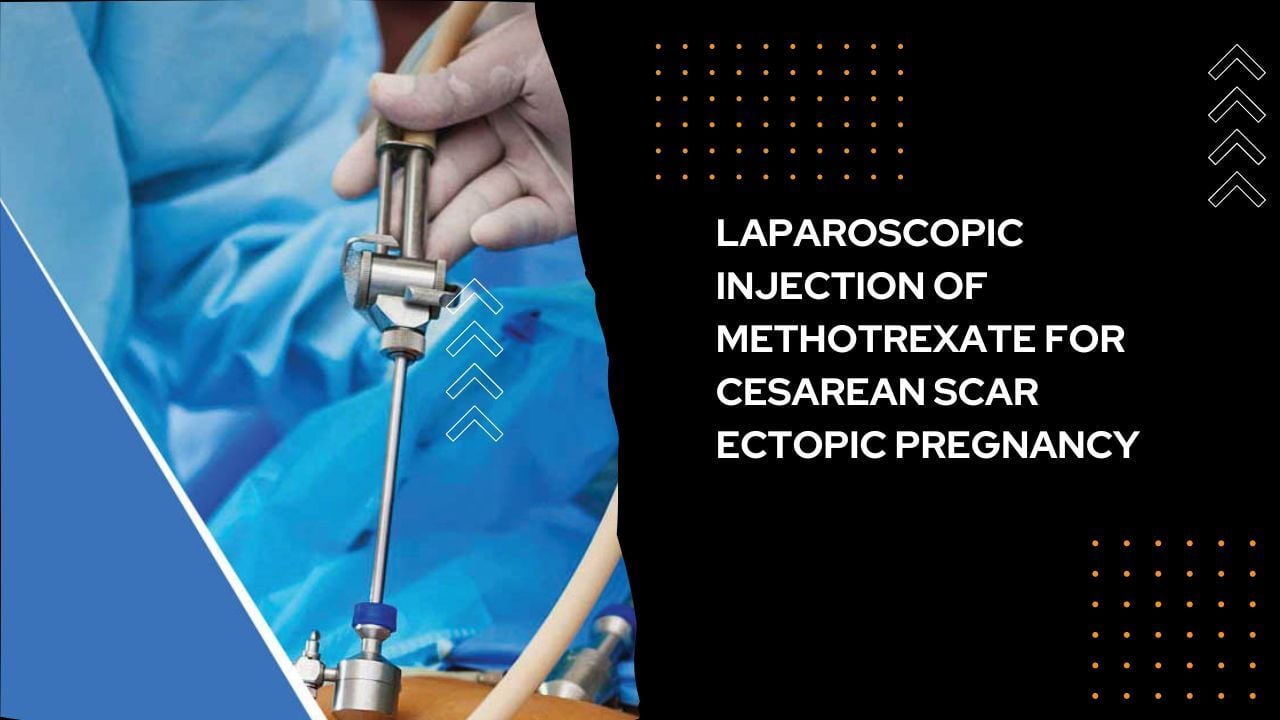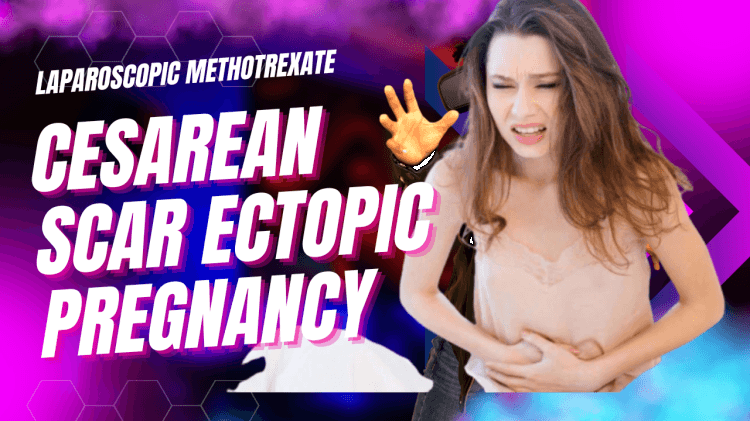A scar ectopic pregnancy, also known as a cesarean scar pregnancy (CSEP), is a rare type of ectopic pregnancy where the fertilized egg implants into the scar tissue left behind by a previous cesarean section (C-section). This type of ectopic pregnancy occurs in the uterine scar rather than the normal location, the uterine cavity.
CSEP is considered a rare and potentially life-threatening condition because the implantation site has a higher risk of poor blood supply and inadequate tissue support, which can lead to complications such as uterine rupture, heavy bleeding, and damage to nearby organs.
Early diagnosis and appropriate treatment are crucial to minimize risks to the mother and preserve future fertility. Treatment options can include medication, such as methotrexate, to stop the growth of the pregnancy, or surgical intervention to remove the ectopic tissue and repair the affected area. The choice of treatment depends on the size, location, and growth of the ectopic pregnancy, as well as the overall health of the patient.
Cesarean scar ectopic pregnancy is a rare and potentially life-threatening condition. Late diagnosis can lead to severe bleeding and a low chance of survival. There is no agreed-upon management for this type of pregnancy. Historically, our facility administered intra-muscular methotrexate injections, which had a high failure rate and often required later surgery. We hypothesized that injecting methotrexate directly laparoscopically into the gestational sac could improve treatment success.
Patients and Methods: In this retrospective, single-center study, we analyzed 12 patients aged 33-42 years (average age = 35 years) with Cesarean scar ectopic pregnancy between 2016 and 202-. Cesarean scar ectopic pregnancy was identified via transvaginal ultrasound at an average gestational age of 8wk. Treatment involved a general anesthetic and laparoscopic guided methotrexate injection into the gestational sac. HCG levels and future childbearing were monitored following treatment.
Results: Half of the patients were asymptomatic at diagnosis. All patients tolerated the treatment well, and all ectopic pregnancies were successfully resolved. HCG levels returned to negative within three months without further medical or surgical intervention. The post-treatment pregnancy rate was 40%.
Conclusions: Our results suggest that laparoscopic-guided methotrexate injection into the gestational sac is a safe and effective treatment for early-stage Cesarean scar ectopic pregnancy in hemodynamically stable patients when performed by a skilled surgical team.
Keywords: Cesarean scar ectopic pregnancy (Cesarean scar ectopic pregnancy), medical treatment, fertility preservation, ultrasound, methotrexate (MTX)
Cesarean scar ectopic pregnancy is a rare gynecological condition that occurs within the scar of a previous Cesarean section. Cesarean scar ectopic pregnancy affects 1 in 1,800 to 1 in 2,216 pregnancies among women with prior Cesarean sections and accounts for 6% of all ectopic pregnancies. The incidence of Cesarean scar ectopic pregnancy has been increasing in recent decades due to the growing number of Cesarean deliveries.
Cesarean scar ectopic pregnancy was first described in 1978 and was initially diagnosed via ultrasound in 1990. Currently, a standard Cesarean scar ectopic pregnancy diagnosis using transvaginal ultrasound involves several criteria, including the presence of a gestational sac at the site of a prior Cesarean section scar and a reduced myometrial thickness between the bladder and the hysterotomy site.
The underlying causes of Cesarean scar ectopic pregnancies (Cesarean scar ectopic pregnancy) are still not well understood. While several potential risk factors have been suggested, none have been conclusively confirmed. Cesarean scar ectopic pregnancy can lead to severe hemorrhage and even death in later stages of pregnancy, so termination is recommended as soon as possible after diagnosis. Some cases have continued into the second and third trimester due to missed diagnoses or patient refusal to terminate the pregnancy. Although there have been a few live births following Cesarean scar ectopic pregnancy, they are rare and carry high risks for both the mother and child.
There is no consensus on the management of Cesarean scar ectopic pregnancy patients, with treatment options including medical or surgical intervention, or a combination of both. Most strategies aim to preserve the patient's fertility. Methotrexate is the most common medical treatment, which can be administered in various ways. Surgical treatments involve resection of the ectopic pregnancy through hysteroscopy, laparoscopy, or laparotomy. Uterine artery embolization may be used prophylactically to reduce the risk of bleeding during other surgical procedures.
The retrospective study provided valuable insights into the management and treatment of Cesarean scar ectopic pregnancy. By injecting methotrexate directly into the gestational sac under laparoscopic guidance, the researchers hoped to improve the success rate of medically treating Cesarean scar ectopic pregnancy. .
Following the laparoscopic methotrexate injection, the patients were closely monitored. HCG levels were regularly checked to confirm the termination of Cesarean scar ectopic pregnancy, and once they returned to negative levels, the Cesarean section scar was assessed for potential residual niches. The study's findings demonstrate that the local laparoscopic guided methotrexate injection into the gestational sac can be an effective treatment for Cesarean scar ectopic pregnancy. However, the success of this technique relies on highly trained personnel capable of performing injections into small gestational sacs. This study adds to the body of knowledge surrounding Cesarean scar ectopic pregnancy management and treatment, highlighting the importance of early diagnosis and appropriate intervention to minimize risks to the mother and child. It also emphasizes the need for further research and the establishment of a consensus on the most effective treatment approaches for Cesarean scar ectopic pregnancy patients.
Cesarean scar ectopic pregnancy diagnosis was made using transvaginal ultrasound and HCG blood tests for pregnancy, with one patient receiving a pelvic MRI scan as well. At diagnosis, gestational sacs measured between 6 and 36 mm. The average gestational age at diagnosis was 8 weeks. In 75% of cases, a measurable fetal echo was identified, with fetal cardiac activity in 80%.
No major complications occurred, and no additional surgical intervention was needed during or after the local laparoscopic guided methotrexate injection. Blood loss was minimal, no blood transfusions were required, and none of the patients needed intensive care.
Three patients were re-admitted within a month following the methotrexate injection for pain and bleeding. HCG levels returned to negative for all patients within an average of 60 days after the methotrexate injection.
The Cesarean niche of all patients was assessed after treatment for possible dehiscence, potential Cesarean scar ectopic pregnancy recurrence, and/or indication for Cesarean section scar resection. Four patients treated became pregnant after the methotrexate injection for Cesarean scar ectopic pregnancy, resulting in a 40% pregnancy rate after treatment.
In conclusion, treating Cesarean scar ectopic pregnancy by injecting methotrexate directly into the gestational sac proved effective, with low complication rates and good preservation of fertility. This technique should be reserved for early cases of Cesarean scar ectopic pregnancy and performed by specialists in centers with experience in managing Cesarean scar ectopic pregnancy and its associated risks. After treatment, an evaluation of the scar should be performed, and the patient's fertility should be carefully monitored.






